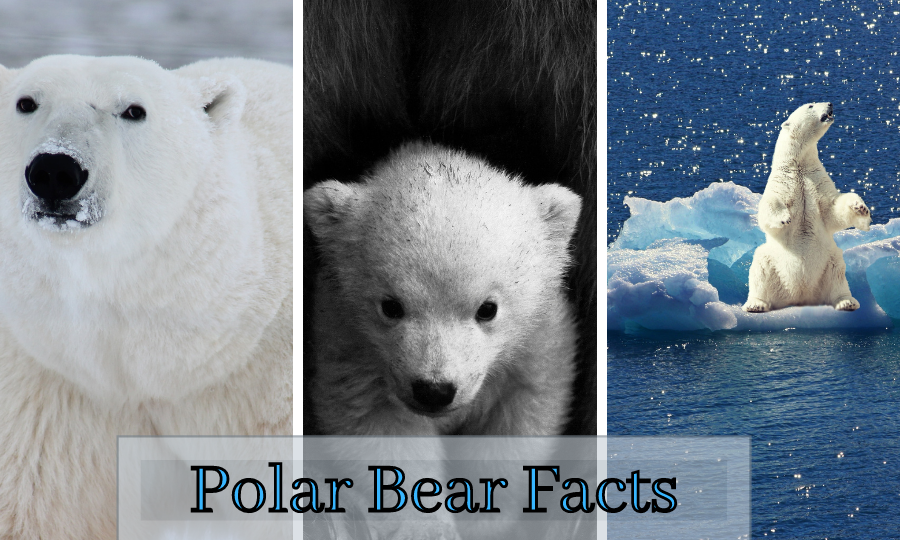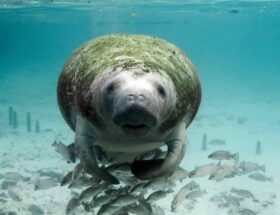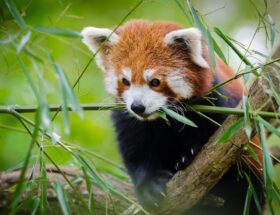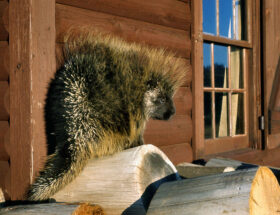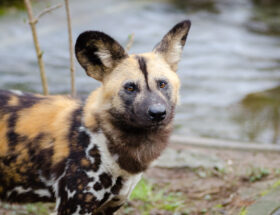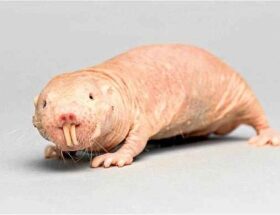In this post, you will find incredible polar bear facts. Information about what polar bears eat, where do polar bears live, polar bear adaptations, why are polar bears endangered, and other surprising fun facts.
Quick and Easy Navigation
What Are Polar Bears and What do Polar Bears Look Like?
Polar bears are marine mammals native to the Arctic Circle. Although they spend a lot of time on land, scientists classify them as marine mammals because of their dependence on sea ice. They are the largest of the bear species and the largest extant land carnivore. The polar bear’s scientific name, Ursus maritimus means “maritime bear”. Polar Bears are not white. Really, their skin is black and is covered with hollow colorless hair. The hollow fur traps the sun’s heat and reflects light giving them a bright white color and providing them with a perfect source of insulation. They have small black eyes and a black nose, small ears and tails, and sharp teeth and claws. Their front paws are large and flat.
Polar Bear size and Weight
Polar bears can grow to be from 8 feet to 11 feet tall and up to 8 feet long. An adult male can weigh between 770 and 1,540 pounds. Adult females are typically half the size of males. Polar Bears are the largest carnivorous land mammals on Earth.
Where Do Polar Bears Live?
There are about 19 different populations of polar bears and they all live in the Arctic region. Governments and scientists have designated these populations depending on 4 different sea ice regions. The formation and melting of sea ice are unique in each of these 4 regions, subjecting polar bears to different survival risks and threats. Each region differs in geography, sea ice levels, and vulnerability to climate change. You can find a detailed description of each of the four regions on the Polar Bear International Organization website. The 4 ecoregions are Seasonal Ice Ecoregion, Divergent Ice Ecoregion, Convergent Ice Ecoregion, and Archipelago Ecoregion.
Polar Bear Facts: Polar Bear Habitat
The polar bear habitat includes Alaska, Canada, Greenland, Norway, and Russia. They live along coasts and ice packs. Today it is estimated that 60% of the world’s population of polar bears live in Canada from James Bay in the south to Ellesmere Island in the north, and east to west from Labrador to the Alaskan border. Churchill in Manitoba Canada is known as the polar bear capital of the world. The polar bear habitat continues to change depending on the distribution of sea ice and seals. For that reason, the polar bear’s home range is larger than any other species of bear. In regions with less sea ice and seals, polar bears travel longer distances and have longer fasting periods. Due to the constant change in their habitat, polar bears do not have territories, unlike any other large carnivore.
Polar Bear Diet Facts: What Do Polar Bears Eat?
The Polar bear is a hyper-carnivorous bear. This means that 70% of their diet is meat. Polar Bears eat mostly seals that they catch on the sea ice and while standing on the edges of sea ice. However, when there is no sea ice present, they live off the fat reserves they have gained during winter. Polar bears are very poor hunters and only 2% of their attempts to catch prey are successful. When they can’t catch a seal, they settle for small mammals, birds, eggs, vegetation, a walrus if they can catch one, and even a whale carcass. Further, in the event that a narwhal or beluga whale gets trapped in small openings in pack ice, they become easy prey for the polar bear.
Polar Bear Facts: Polar Bears Adaptations
Polar bears are well-adapted to survive in the harsh environment of the Arctic region. Their hollow fur traps heat for insulation. The fur is also very thick, completely covering their black skin. The color of the skin further works to attract the sun’s rays. Additionally, they have a layer of fat called blubber to protect them from the cold air and water. They also have flat front paws that help them swim so they can travel in the water when searching for food. Moreover, their soles are covered in fur similarly to other arctic animals like the snowy owl and the arctic fox.
Indeed, the fur in the soles gives the polar bear a better grip when walking on ice and also keeps their paws warm. They have very sharp teeth and claws for hunting and digging. The small ears and tails are for reducing heat loss. Adding to their adaptability, Polar bears can go months without eating when food is scarce. They are able to adapt to food deprivation by slowing down their metabolism and transform into a hibernation-like state.
{RELATED POSTS: Facts About The Snowy Owl. Facts About The Arctic Fox}
15 Interesting Facts About Polar Bears
- Polar bears are pretty quick on their feet, able to reach speeds of up to 25 mph.
- Polar bears are excellent swimmers. They use their front paws as paddles and their back legs to steer, reaching speeds of up to 6 mph. And, they can swim great distances. Sometimes it can take hours or even days to reach the next sea ice.
- Polar bears roll on the snow or go for a swim to clean themselves. Keeping their fur clean helps maintain the insulating properties of their fur and also helps them cool off when they get too hot.
- Polar bears have an incredible sense of smell and can smell a seal from half a mile away.
- Polar bears are adapted to survive the cold temperatures of the Arctic, which can drop to -50°F during the winter. In the summer, however, they run the risk of overheating as temperatures rise to 68°F.
- Polar bears are solitary and mainly live and hunt alone.
- Polar bears’ hairs are about 2 to 6 inches long. Their coat turns yellow as they age.
- Polar bear lifespan: In the wild, polar bears typically live between 15 to 18 years but can reach 30 years of age. In captivity, some have lived up to 40 years.
- Polar bears love to feed on ringed and bearded seals.
- The ringed seals are most abundant during the months of April through July. Indeed, this is an important time for polar bears and they must take advantage of the abundance of food during this time and build up their body fat stores to survive the months when food is scarce.
- Polar bears can go months in starvation. In fact, they can lose half of their body mass during this time.
- Polar bears do not hibernate. Instead, they enter into a type of dormancy and reduce their heart rate, metabolism, and temperature to conserve energy.
- Polar bears do not have natural predators in the wild.
- Are polar bears friendly to humans? No! polar bears are not friendly to humans. They are quite dangerous, not only because they are large and powerful but also because they are naturally curious and are not afraid of humans.
- Polar bears have a total of 42 teeth.
Polar Bear Fun Facts
- Scientists have figured out they can extract the DNA of a polar bear from its tracks. The WWF developed an innovative new technique to isolate DNA from a polar bear’s footprint in the snow and the DNA of the seal it ate.
- Grizzly-Polar Bear Hybrids have been confirmed through genetic testing.
- Scientists discovered by accident that polar bears can become invisible! They are invisible to infrared cameras.
Polar Bear Reproduction
The breeding season is between March and July. However, Polar bears only breed once every three years. Cubs are born after an 8-month gestation period. Female polar bears give birth to their cubs in snow dens they dig themselves. These dens help protect the cubs and keeps them warm. A newborn cub is about 12 inches long and weighs one pound. The males do not help protect their cubs. The baby polar bears stay within the dens for four to five months, They stay with the mothers for about two years learning important survival skills.
Polar Bears Population
Scientists estimate that there are about 20,000 to 25,000 polar bears left in the world.
Conservation: Why Are Polar Bears Endangered?
Polar Bears are currently listed in the IUCN Red List of Threatened Species as Vulnerable. Unfortunately, polar bears face many challenges to survive in the advancing world we live in today. The main threat to polar bears is the effect global warming has on sea ice. Most critically, higher temperatures are melting the sea ice earlier each year and forming later in the winter. The shrinking sea ice makes it harder for polar bears to effectively hunt for seals which is their main source of food. Polar bears use sea ice as a platform to hunt for seals from above the water. They don’t catch seals in the open water.
Other threats include hunting and pollution. An increase in pollutants around the world is negatively affecting polar bears. Furthermore, harmful pesticides generally find their way into oceans and the habitats in which animals live. Polar bears are at the top of the food chain in the arctic and end up eating the polluted animals. Pollution from oil spills also ends up in the arctic oceans and damages the polar bear’s fur, putting them at risk of hypothermia. Unfortunately, despite bans on hunting and quotas, illegal hunting still takes place.
Adopt A Polar Bear – WWF
International Polar Bear Day
February 27 is International Polar Bear Day. The date was established by the Polar Bears International organization with the goal of raising awareness about the impact global warming has on these incredible polar bear populations. On this day, the Polar Bears International organization encourages people to find ways to live more sustainably and reduce their carbon output.
